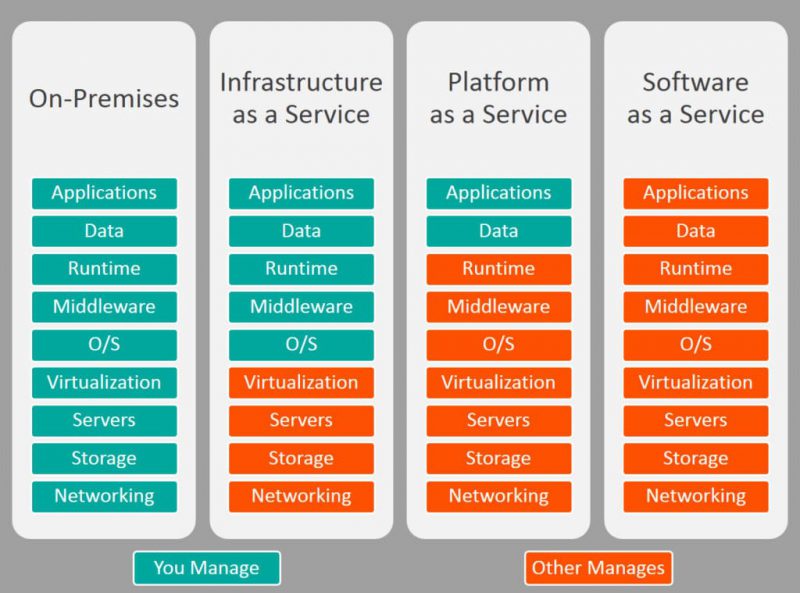
Is it possible for your small to medium firm to consistently outperform larger, more established competitors? To produce the kind of performance, value and profit and your firm needs to grow rapidly?
It’s tough at times, isn’t it?
Many attorneys are looking for a way to produce stellar work and irresistible results for their clients. There’s a simple platform top performing firms are using to run circles around their larger and better-funded competitors.
I’m talking about the cloud and cloud software.
What exactly is ‘the cloud?’
If you’re a sophisticated professional you already know what I mean by “the cloud.” But, in the spirit of clarity, let’s make sure we’re all on the same page.
Here’s a simple definition of the cloud:
The cloud is a global network of remote servers that store data, run applications, and deliver services, allowing you to access information online from any internet-capable device.
These services differ dramatically from on-premise software that’s installed locally on hardware you manage and control.
| On-premise responsibilities | |
| Applications | Data |
| Runtime | Middleware |
| O/S | Virtualization |
| Servers | Storage |
| Networking | Security |
That’s a heavy burden for small-to-medium firms and it’s a lot to manage. But these are the requirements needed to effectively protect your apps, data, environment and security.
Enter cloud software.
The cloud comes in three distinct flavors.
- Infrastructure-as-a-service (IaaS) i.e. hosting companies like Rackspace and Amazon Web Services are self-service platforms that give you a significant degree of control and responsibility
- Platform-as-a-service (PaaS) e.g. Google App Engine and Force.com enables sophisticated, medium-sized firms to instantly scale their technology and performance needs up or down depending on demand
- Software-as-a-service (SaaS) e.g. Dropbox, Google Drive, Bill4Time, Microsoft Office 365, these provide firms with a vendor managed option that enables them to focus on running and managing their firm.
Here’s how these options are different.

This is the key.
This is the secret successful firms use to grow rapidly and safely. Using ‘the cloud,’ firms are able to boost their firm’s performance dramatically in key areas such as:
- Utilization
- Billing / collection realization
- Profit per partner/employee
- Client retention
- Profit per client/project
- Expenses (individual and firmwide)
Is this a hard sell? Not at all.
Cloud software eliminates many of the large burdens authorities expect firms to carry.
But how?
How does cloud software boost your firm’s performance
What’s so special about the cloud?
To answer this question, we need to take a look at some of the struggles firms are dealing with today. These issues are the natural outworkings of on-premise software.
What sort of struggles are we talking about?
Access
- Attorneys lose 2.3 hours a week searching for (not finding) documents and files
- According to AIIM, 81 percent of law firms struggle with sharing information across multiple platforms (e.g. mobile, tablet and desktop)
- An IDC whitepaper found attorneys and firm knowledge workers lose an additional 2 hours per week due to document management challenges
- Firms lose an additional $9,071 per person, per year and they experience a 8 percent decrease in firm productivity
Timekeeping/billings
- Firms using spreadsheets to track billable time lose $86,294 to $106,294 per person, per year
- Attorneys who wait till the end of the month to record their time overbill their clients by 23 percent
- Attorneys lose 50 to 70 percent of their income if they wait one week to record their time
- AffinityLive found firms lost an additional $50,000 per person, per year due to insufficient time tracking
- Attorneys spend (lose) 6 hours per day on nonbillable work
- Hourly rates at firms continue to climb while realization rates continue to fall
Security
- According to a recent study, 70 percent of IT managers surveyed “know or believe that users (employees) have business (client) data in their own personal file-sharing accounts.”
- A LogicForce report found 77 percent of firms surveyed do not have cybersecurity insurance, 95 percent were non-compliant with their own security policies and 100 percent were non-compliant with client policies
- A whopping 53 percent of firms do not have a data breach incident response plan
- Attacks on law firms are on the rise. Approximately 80 percent of the largest firms in the United States have experienced a malicious attack
- Attacks on small firms are also on the rise. Stories like the 2017 attack on Moses Alfonso Ryan shows firms are easy targets for criminals but are often under-reported by media outlets
- A Verizon report found that legal professionals were the easiest to hack
Did you catch that?
The common thread behind each of these serious issues? It’s easy to simply hang the responsibility around the necks of individual attorneys, to suggest they’re failing in some way.
It’s not true.
There’s a more pressing issue at play here. It’s something more simple.
Attention.
Attorneys, like any professional, perform best when they’re able to focus their attention on the work they do on behalf of their clients. It really is about the advocacy.
Are they focused on that?
Not a chance. Most attorneys are focused on a bevy of nonbillable tasks. The administrative, managerial and business development tasks they’re required to do to maintain or exceed performance standards.
Attorneys are pulled in multiple directions
It’s constant.
There’s a never-ending demand on attorneys to remember everything, to please everyone. If you’re running a small firm, the bulleted list above isn’t a list of everything you have to manage.
Not even close.
Here’s a question though. Would you have the mental bandwidth, the ability to solve each of the above issues using brainpower alone? Would you be able to do that and take exceptional care of your clients?
It’s an unreasonable ask, right?
This is why the cloud matters to law firms. The cloud enables you to solve the underlying problem at play, the common thread lurking behind each of these challenges. How you ask?
With software.
Wait just a minute here. On-premise software, applications installed at your location can provide the same functionality as cloud software, right? If that’s actually case, there’s an obvious question.
Why do I need cloud software?
The subtle weakness of on-premise software
Everything depends on you.
As we’ve seen above, it all depends on you. Does your vendor provide you with a consistent stream of updates and support? That’s fantastic.
It just isn’t all that helpful.
- You have to update your operating system.
- You’ll have to manage licensing, patches and updates
- You’re responsible for updating your anti-virus and malware detection tools
- You’re responsible if a crisis takes your system down/offline
- If you lose your client’s data you’re solely responsible
- You’re responsible for securing and protecting your (firm/client) data, apps and environment
- You’re responsible for backups and archives
A failure on any of these fronts means:
- You’re solely responsible/liable for any failure
- If you fail, your firm may not be able to continue to operate unimpeded
- Clients will naturally hold you responsible for any failure
- You’ll need to navigate the post-failure landscape dealing with the publicity, legalities, optics and framing of your situation
You can do it with on-premise software. But only if you have the right technology, tools and team to support you. Here’s why that’s still a problem.
Attention.
You’re still required to focus a significant amount of your time and attention on these details.
Cloud software won’t save your firm
It will build your firm.
What’s the difference? Firm saving behavior typically involves patching behavior, putting temporary stop gaps in place to compensate for poor habits and behavior.
Here’s an example from a case study.
“Lawyers would send me their time every month by email and would come in all different formats and all different conventions and levels of granularity. And even the units would vary somewhat. Some would use a tenth of an hour or some would use quarter hours, some would use a third of an hour, it was a mess…”
– Benjamin Lieber, Managing Partner, Potomac Law Group
The attorneys in Lieber’s firm would send him their time sheets in a variety of formats and conventions. Think about the difficulty involved with converting that. Then there’s the issue of reconstructive billing. Attorneys would reconstruct (guess) their time at the end of the month.
Remember the issues I mentioned earlier?
- Firms using spreadsheets to track billable time lose $86,294 to $106,294 per person, per year
- Attorneys who wait till the end of the month to record their time overbill their clients by 23 percent
- Attorneys lose 50 to 70 percent of their income if they wait one week to record their time
- AffinityLive found firms lost an additional $50,000 per person, per year due to insufficient time tracking
- Attorneys spend (lose) 6 hours per day on nonbillable work
- Hourly rates at firms continue to climb while realization rates continue to fall
How would cloud software deal with these issues?
- Firm time tracking would be automatic
- Time tracking is recorded as-it-happens, never reconstructed
- As-it-happens timekeeping would add an immediate revenue boost of 50 to 70 percent (or more)
- Tasks and projects would be automatically converted to time entries and billed appropriately
- Descriptive line items and reminders regarding billing guidelines would reduce billing disputes increasing collection realization rates further
- Firm utilization rates would improve dramatically as attorneys were able to reduce nonbillable time lost to administrative work (e.g. filling out time sheets or creating invoices)
It’s an easy way to immediately boost your firm’s revenue.
How do I know?
Benjamin Lieber shares the proof. His virtual law firm achieved an incredible 1233 percent growth, growing from 7 to 80 attorneys in eight years. Would on-premise have achieved the same results?
The likelihood of success is low.
How do we know?
Clearspire.
Clearspire was a venture-backed competitor. They raised more than five million dollars. They opened an office just down the street from the White House. They received regular write-ups in The Wall Street Journal and the Washington Post. They were a virtual law firm flush with cash.
What did they do with all their cash?
They decided to build Coral, their very own billing, document and practice management platform. Their goals with Coral were ambitious.
They built their on-premise software/platform.
Where are they now?
Out of business.
Their law firm needed to focus on the advocacy. They decided instead to focus on building their own on-premise software platform. It killed their business within the first four years of opening.
Potomac used the cloud to grow.
They achieved incredible growth, producing value for their clients and the partners in their firms.
Cloud software makes meteoric growth possible
Is it possible for your small to medium firm to consistently outperform larger, more established competitors? To produce the kind of performance, value and profit and your firm needs to grow rapidly?
It’s completely possible.
With the cloud computing and a proven platform, your firm will have the structure and support it needs to produce stellar work and irresistible results for your clients.
I’m talking about the cloud.
Do what top performers do. Use cloud software and your small size to run circles around your larger and better-funded competitors. Work with a trusted provider. Shift your attention to the advocacy, to your clients, to the details that matter most. You’ll find success becomes predictable and attainable.






 Bill4Time product team releases new and enhanced features, system improvements, and bug fixes several times per week. Organized by month, the Release Notes blog series will highlight all the changes we’ve implemented, so you can easily stay up-to-date on what’s new.
Bill4Time product team releases new and enhanced features, system improvements, and bug fixes several times per week. Organized by month, the Release Notes blog series will highlight all the changes we’ve implemented, so you can easily stay up-to-date on what’s new.